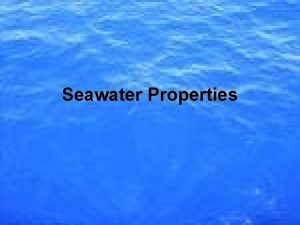The urchin on the right grown in seawater




- Slides: 4

The urchin on the right, grown in seawater under today's air conditions (400 ppm), is healthy and has normal spines. The urchin on the left, grown under very high CO 2 conditions (2, 850 ppm), is substantially damaged by the more acidic conditions. Weighing the urchins confirmed that they were actually dissolving in the more acidic high CO 2 conditions. (Micrograph below by Justin Ries, WHOI, and photo by Tom Kelindinst, WHOI)

In a surprising result, the lobster on the right, grown under a very high level of CO 2 (2, 850 ppm, or 10 times pre-industrial levels) grew a larger, heavier shell than the lobster on the left, grown under today's CO 2 level (400 ppm). (Photo courtesy of Justin Ries, University of North Carolina)

Blue crabs (Callinectes sapidus) grown for two months under today's CO 2 levels of 400 ppm (left) and under very high CO 2 levels of 2, 850 (right). This species showed an unexpected response to CO 2 level—the crab grown under the highest level (representing ten times the level of CO 2 in the pre-industrial atmosphere) grew a heavier, larger shell. (Photos courtesy of Justin Ries, University of North Carolina)

On the left, a conch from seawater under today's CO 2 levels (400 parts per million, or ppm) has a normal shell, with normal bumpy protuberances. The conch on the right, reared under very high CO 2 conditions (2, 850 ppm), has a shell that has begun to deteriorate, its protuberances dissolved away in the more acidic seawater. (Photo by Tom Kleindinst, Woods Hole Oceanographic Institution)







